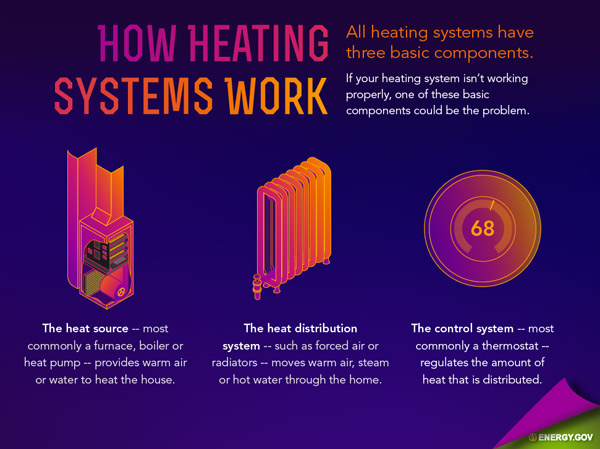Many homes and businesses in Vermont can save significantly when it comes to heating and cooling. The first step is often to make sure you are keeping the warm air in and the cold air out in the winter (or the reverse in the summer), so you cut the waste from leaks. (Visit the Weatherization section of this site for more information on this.)
As with many household appliances, technology has increased the efficiency of many heating and cooling devices. This section can help you understand your current heating and cooling systems, when you might consider replacing them, and some options for saving money and energy while improving the comfort of your building.
Heating and Cooling Technologies
- Furnaces heat air then distribute it through ducts throughout a building. Boilers heat water and distribute it (either as water or steam) through pipes that feed radiators. These are considered “central” heating systems. Furnaces and boilers generally burn a single source of fuel, such as propane, fuel oil, wood pellets, firewood, or natural gas.
- Electric resistance heating has gradually been displaced in Vermont, due to its relative inefficiency and high cost (although some homes may retain electric baseboard heat in remote bedrooms and bathrooms). These older heating system types include electric baseboard heaters, electric furnaces, electric thermal storage and electric wall heaters.
- Stoves are standalone units fueled by wood pellets, firewood, propane, or gas. The type of wood, how dry it is, and the stove design can all contribute to the efficiency of wood-burning units.
- Portable Heaters can easily be moved from room to room as your needs change throughout the day. These are usually electric resistance heaters that are not very efficient.
- Wall Units are fixed in place and may be used to supplement heat in a particular area. If fueled by kerosene, gas, or propane they need to be vented directly to the outside. Electric resistance wall units do not require venting. Electric wall-mounted heat pumps are typically more efficient than electric resistance units and can be used for both heating and cooling.
- Fireplaces are a wonderful focal point for a room, but can be very inefficient at heating because most of the heat goes up the chimney. In fact, large amounts of the heat generated by a central heating system can be lost when a fireplace is burning because it pulls cold air in through leakage points in the building. Fireplaces should have their own dedicated combustion air supply, and fireplace dampers should be shut tightly when the fireplace is not in use.
- Masonry Heaters typically produce more heat than other wood- or pellet-burning appliances. Masonry heaters include a firebox, a large masonry mass (such as bricks), and long, twisting smoke channels that run through this mass.
- Outdoor Wood Boilers are located outside a building’s thermal envelope and tend to be less efficient than wood-heat systems.
Learn More
Vermonters interested in heating their homes without fossil fuels have a new resource to help them navigate the path towards clean heating. The guide, titled "A Vermonter's Guide to Residential Clean Heating and Cooling," was produced by the nonprofit Clean Energy States Alliance (CESA) for the Vermont Department of Public Service. The guide is available for download here.
The Vermont Department of Public Service website contains information on the retail prices of heating fuels in the state.
If you heat with wood, or plan to heat with wood, the Department of Environmental Conservation offers some health and environment considerations and the Department of Forests, Parks and Recreation offers some resources on safety.
US DOE's Energy Gov website provides an entire section on heating and cooling, which you may want to visit.
Visit the pages below to learn more about Heating & Cooling:







